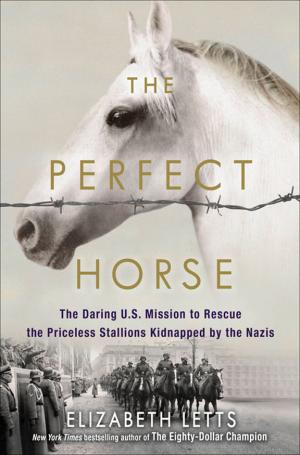Book Review by Tommy Brannon
History and horses come together in this well told story by Elizabeth Letts, author of the Eighty Dollar Champion (Reviewed by the Mid-South Horse Review, December, 2014 http://www.midsouthhorsereview.com/news.php?id=5685)
Readers may be familiar with the rescue of the Lipizzaner stallions of the Spanish Riding School in Vienna, Austria that took place at the end of WW II. Many horse enthusiasts have watched 1963 Disney movie, Miracle of the White Stallions, which somewhat inaccurately dramatizes the story. The true story, told in depth, in this book is much more dramatic, complex, heroic, frightening, lucky, and tragic.
The heroes in the story are not all 100% virtuous, but are, in the sense that they have a love for horses and are willing to make great sacrifices for them. The author begins with an explanation of the European political situation as it related horse breeding, in the 1930’s and 1940’s, with the rise of the Nazi party in Germany, the Austrian anschluss, and the German invasion of Poland, which started WWII. She introduces the Austrian, Alois Podhajsky, with the Spanish Riding School as a dressage competitor at the 1936 Olympic Games in Berlin. Just two years later in 1938, when Austria was absorbed by Germany and the Spanish Riding School taken over by the German army, Podhajsky had to don the uniform of the Wehrmacht to keep the school intact.
Gustav Rau was the civilian Chief Equerry of the Third Reich’s horse breeding program, and had been instrumental the horse industry’s recovery after WW I. Under the Nazi regime, he set up a system of breeding farms throughout Germany and occupied Eastern Europe to supply horses for farming, industry and the German army. Included in this string of horse farms was the confiscated Polish Arabian stud farm at Janow Podlaski Poland. Unlike the U.S Army, that mechanized and divested of horse mounted troopers quickly after it entered WW II, the German army kept an active mounted cavalry and used horses to pull artillery and wagons throughout the war. In all, the Third Reich employed 2.7 million horses by 1945. Towards the end of the war, Rau directed the removal of many of the best breeding stock in Eastern Europe to a stud farm in the Czechoslovakian town of Hustau for safety.
Other characters in this play of real life were the German veterinarian Rudolf Lessing and the director at Hustau, Hubert Ruddofsky. These two risked summary executions at the hand of their superiors to orchestrate a rescue of the horses from the grasp of the Soviet Army. The horses included mares and newborn foals, as well as stallions. The plan was to surrender the facility to the American Army, which had just fought its way across France and Germany and had orders to hold up just across the border in Bavaria, awaiting a link up with the Red Army.
In a case of the right (sympathetic) people being at the right place at the right time, the American Army unit across the border was the U.S. 2nd Cavalry (Mechanized) commanded by a career horse cavalry officer and polo player Colonel Hank Reed. Also in this unit was another old horse solder Captain ”Quin” Quinlivan, as well as a Tennessee Senator’s son and experienced rider ,Captain Tom Stewart. The commander of the Third Army, of which the 2nd Cavalry was a part, was General George Patton. General Patton had also been a cavalry officer and polo player. Hank Reed risked the political fallout and combat with a desperate enemy, and even Czech partisans, to capture Hostau and rescue the horses.
Among the horses at Janow, Podiaski, Poland, and later Hostau, Czechoslovakia were the Polish Arabian stallions Witez and Lotnik who escaped the death and destruction of the war multiple times. They were moved by train, truck, and hoof across three European borders, and survived a harrowing Atlantic crossing. These “war orphans,” amongst others, were eventually auctioned off by in indiferent U.S. government. Fortunately these stallions, after some disinterest and neglect in America, found their way into good homes and lived into their twenties – halfway around the world from their birthplace! Witez, in particular, became the darling of horse enthusiasts worldwide; his likeness was used for horse photo albums, a painting, books, inspiration for the movie The Black Stallion, postage stamps, and a Breyer Horse.
Letts starts each chapter by establishing the date and place, thus she is able to move back and forth in time and place throughout the book, so that the reader is not chronologically confused. She also gives a synopsis of characters, both human and equine, at the end of the book, and relates what happened later in their lives.
For more information about Elizabeth Letts and her books, visit her website: www.elizabethletts.com. We also recommend a related video: the promo video for the Temple Lipizzans at John Borys Photography:
http://www.johnborysphotography.net/#!tempel-lipizzans/cg5o.We guarantee you’ll get chills watching it! The book is published by Ballantine Books and will be available August 23, 2016.
History and horses come together in this well told story by Elizabeth Letts, author of the Eighty Dollar Champion (Reviewed by the Mid-South Horse Review, December, 2014 http://www.midsouthhorsereview.com/news.php?id=5685)
Readers may be familiar with the rescue of the Lipizzaner stallions of the Spanish Riding School in Vienna, Austria that took place at the end of WW II. Many horse enthusiasts have watched 1963 Disney movie, Miracle of the White Stallions, which somewhat inaccurately dramatizes the story. The true story, told in depth, in this book is much more dramatic, complex, heroic, frightening, lucky, and tragic.
The heroes in the story are not all 100% virtuous, but are, in the sense that they have a love for horses and are willing to make great sacrifices for them. The author begins with an explanation of the European political situation as it related horse breeding, in the 1930’s and 1940’s, with the rise of the Nazi party in Germany, the Austrian anschluss, and the German invasion of Poland, which started WWII. She introduces the Austrian, Alois Podhajsky, with the Spanish Riding School as a dressage competitor at the 1936 Olympic Games in Berlin. Just two years later in 1938, when Austria was absorbed by Germany and the Spanish Riding School taken over by the German army, Podhajsky had to don the uniform of the Wehrmacht to keep the school intact.
Gustav Rau was the civilian Chief Equerry of the Third Reich’s horse breeding program, and had been instrumental the horse industry’s recovery after WW I. Under the Nazi regime, he set up a system of breeding farms throughout Germany and occupied Eastern Europe to supply horses for farming, industry and the German army. Included in this string of horse farms was the confiscated Polish Arabian stud farm at Janow Podlaski Poland. Unlike the U.S Army, that mechanized and divested of horse mounted troopers quickly after it entered WW II, the German army kept an active mounted cavalry and used horses to pull artillery and wagons throughout the war. In all, the Third Reich employed 2.7 million horses by 1945. Towards the end of the war, Rau directed the removal of many of the best breeding stock in Eastern Europe to a stud farm in the Czechoslovakian town of Hustau for safety.
Other characters in this play of real life were the German veterinarian Rudolf Lessing and the director at Hustau, Hubert Ruddofsky. These two risked summary executions at the hand of their superiors to orchestrate a rescue of the horses from the grasp of the Soviet Army. The horses included mares and newborn foals, as well as stallions. The plan was to surrender the facility to the American Army, which had just fought its way across France and Germany and had orders to hold up just across the border in Bavaria, awaiting a link up with the Red Army.
In a case of the right (sympathetic) people being at the right place at the right time, the American Army unit across the border was the U.S. 2nd Cavalry (Mechanized) commanded by a career horse cavalry officer and polo player Colonel Hank Reed. Also in this unit was another old horse solder Captain ”Quin” Quinlivan, as well as a Tennessee Senator’s son and experienced rider ,Captain Tom Stewart. The commander of the Third Army, of which the 2nd Cavalry was a part, was General George Patton. General Patton had also been a cavalry officer and polo player. Hank Reed risked the political fallout and combat with a desperate enemy, and even Czech partisans, to capture Hostau and rescue the horses.
Among the horses at Janow, Podiaski, Poland, and later Hostau, Czechoslovakia were the Polish Arabian stallions Witez and Lotnik who escaped the death and destruction of the war multiple times. They were moved by train, truck, and hoof across three European borders, and survived a harrowing Atlantic crossing. These “war orphans,” amongst others, were eventually auctioned off by in indiferent U.S. government. Fortunately these stallions, after some disinterest and neglect in America, found their way into good homes and lived into their twenties – halfway around the world from their birthplace! Witez, in particular, became the darling of horse enthusiasts worldwide; his likeness was used for horse photo albums, a painting, books, inspiration for the movie The Black Stallion, postage stamps, and a Breyer Horse.
Letts starts each chapter by establishing the date and place, thus she is able to move back and forth in time and place throughout the book, so that the reader is not chronologically confused. She also gives a synopsis of characters, both human and equine, at the end of the book, and relates what happened later in their lives.
For more information about Elizabeth Letts and her books, visit her website: www.elizabethletts.com. We also recommend a related video: the promo video for the Temple Lipizzans at John Borys Photography:
http://www.johnborysphotography.net/#!tempel-lipizzans/cg5o.We guarantee you’ll get chills watching it! The book is published by Ballantine Books and will be available August 23, 2016.








